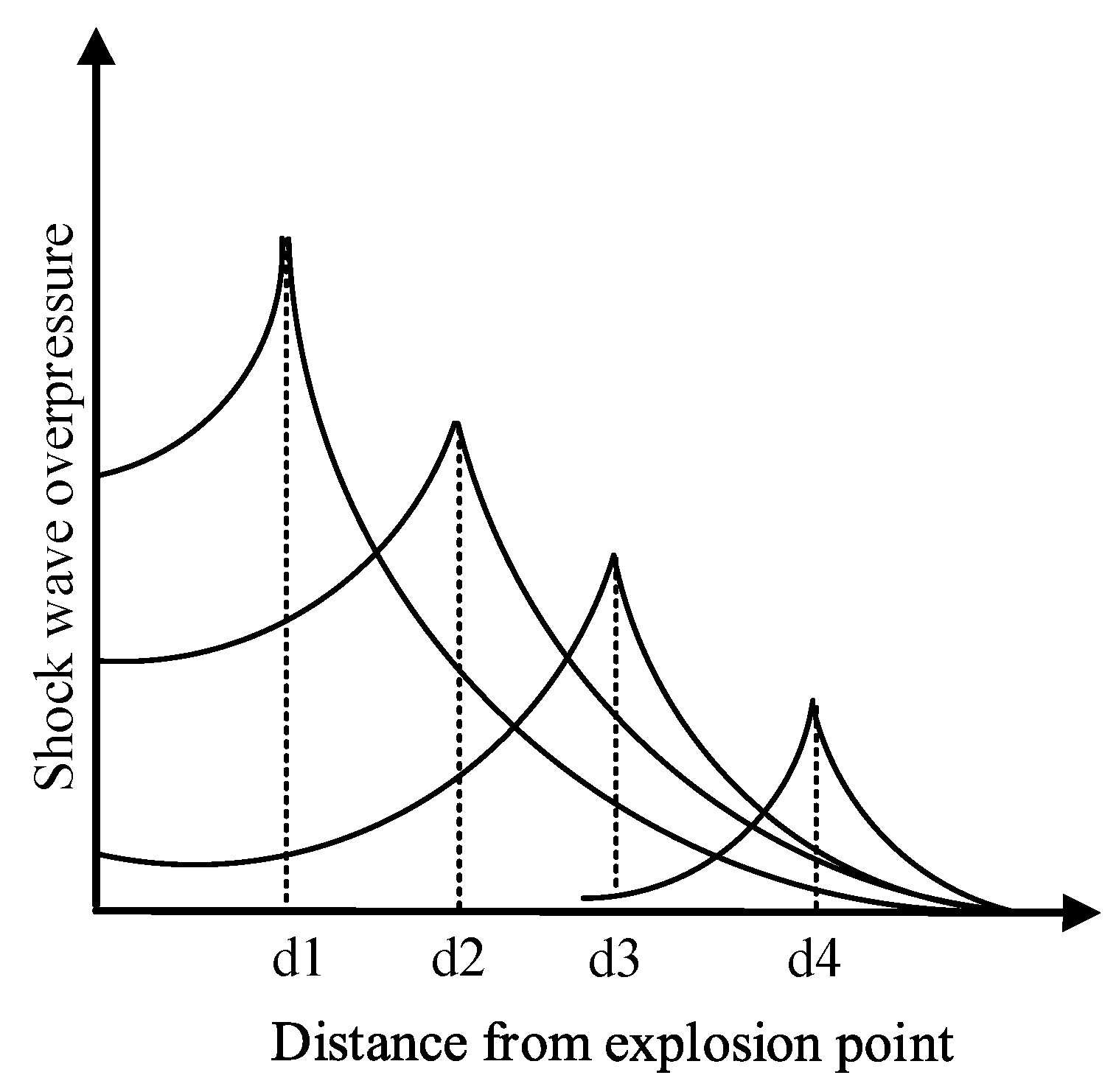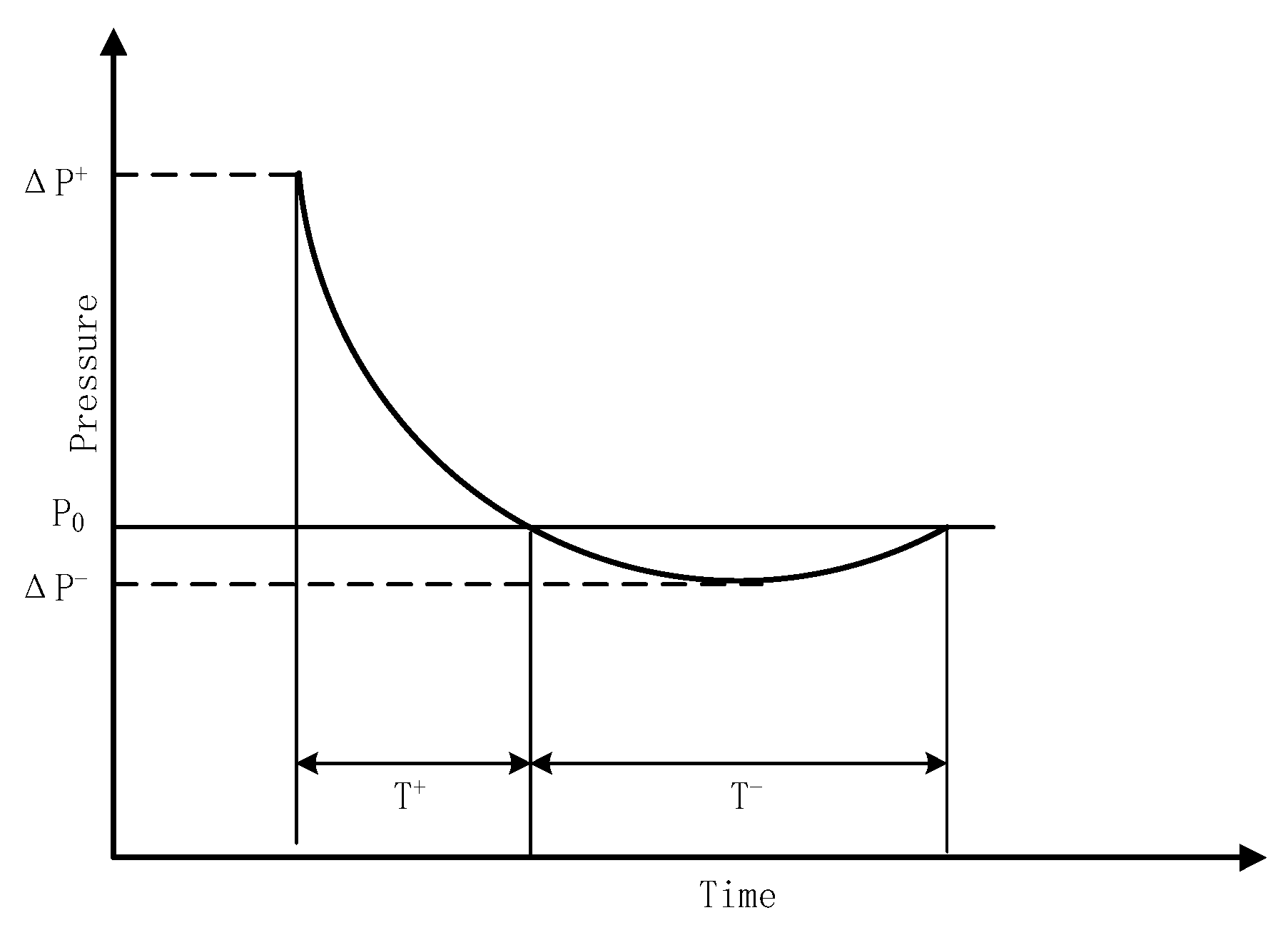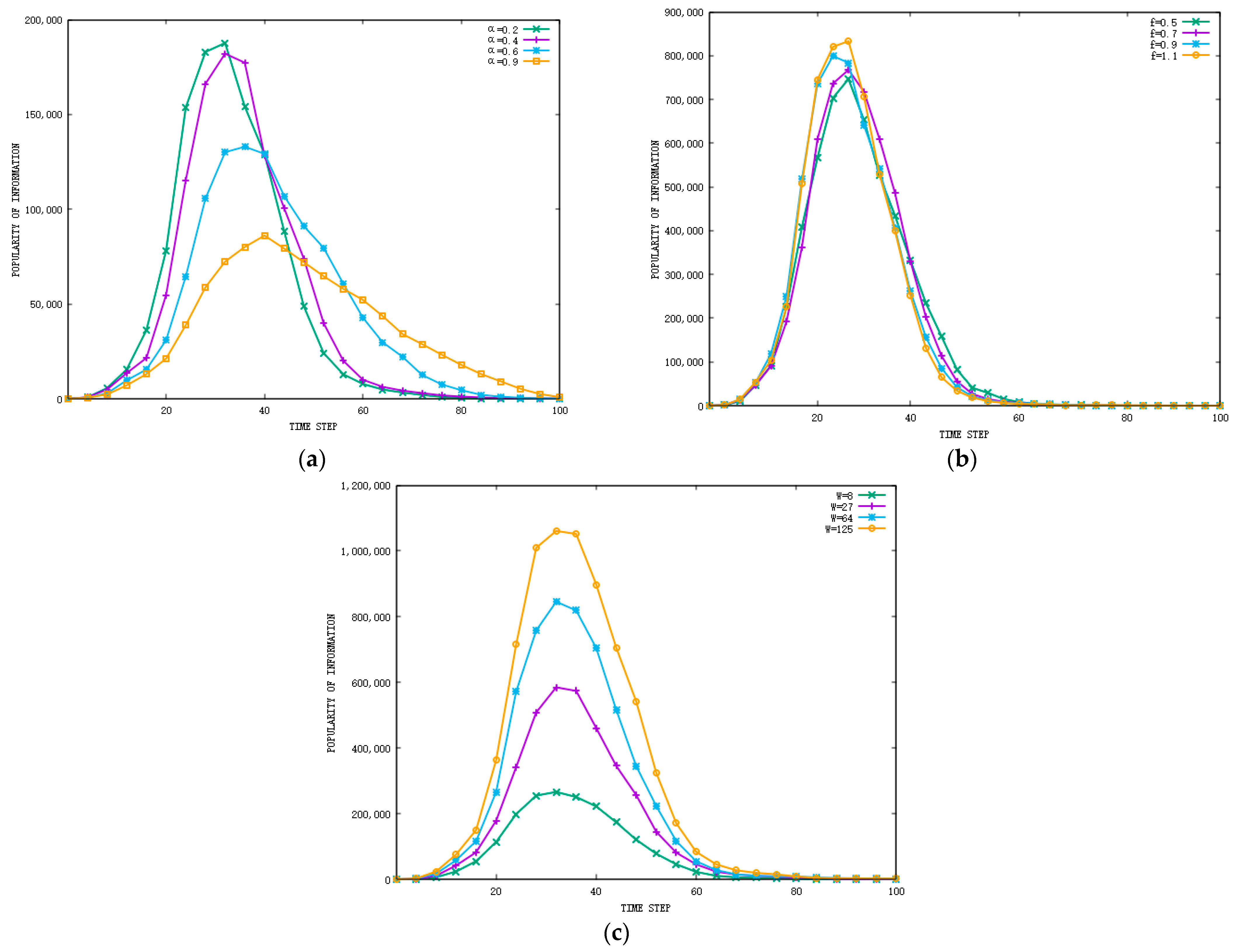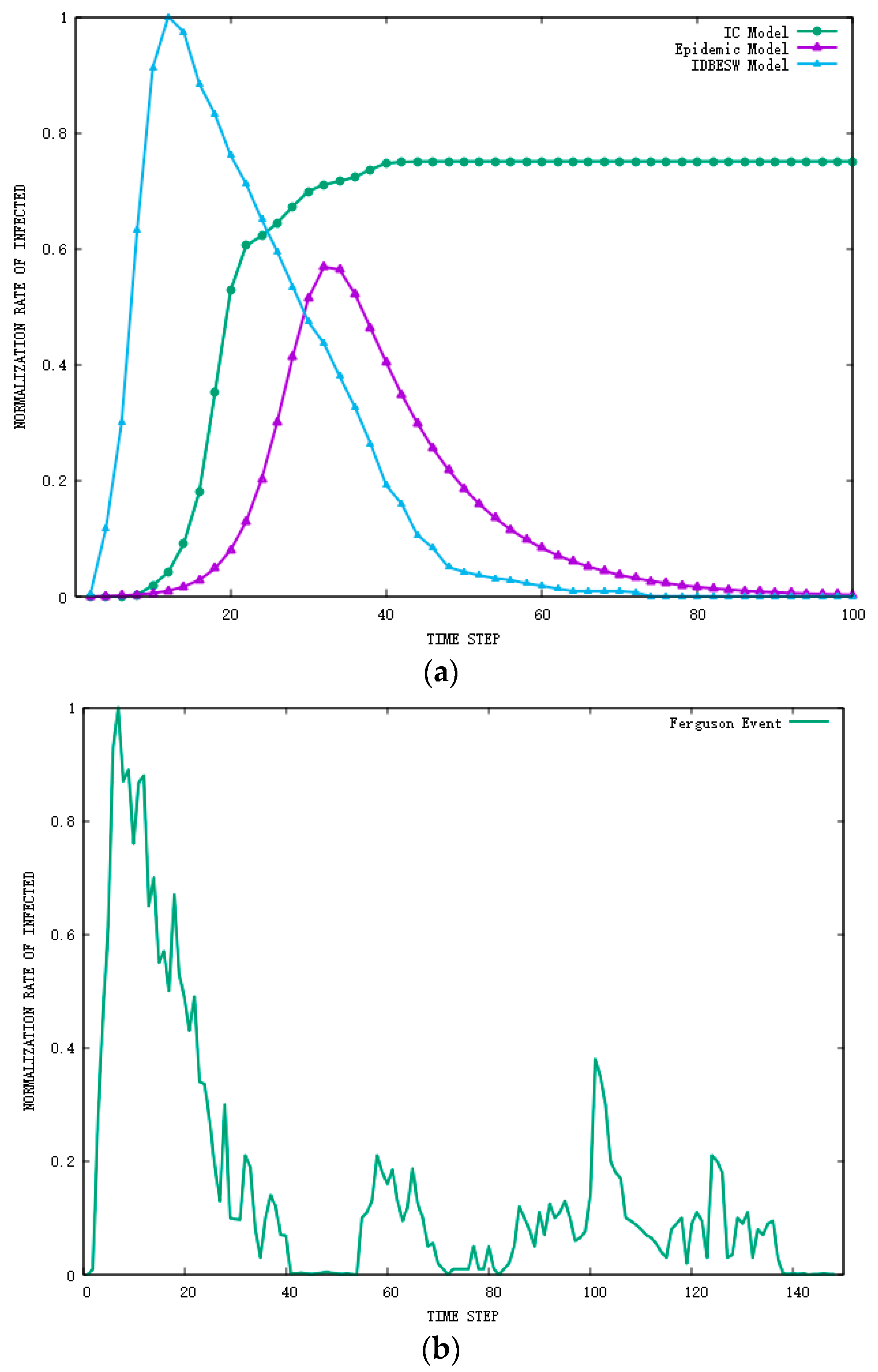An Information Diffusion Model Based on Explosion Shock Wave Theory on Online Social Networks
Abstract
:1. Introduction
2. Related Work
2.1. Information Diffusion Models
2.2. Explosive Shock Wave
3. Proposed Method
3.1. Information Diffusion Model
3.2. Information Diffusion Process
| Algorithm 1 Information diffusion based on IDBESW model |
| Input: An OSN , initial state of all nodes , the Information value , the queue of seed nodes |
| Output: The state of all nodes at the end |
| 1: while do |
| 2: for do |
| 3: for do |
| 4: // sends information with , accepts with |
| 5: if is activated) |
| 6: // add in queue |
| 7: end if |
| 8: end for |
| 9: poll // remove from the queue |
| 10: end for |
| 11: update |
| 12: end while |
4. Experiments and Discussion
4.1. Experimental Setup
4.1.1. Dataset Description
4.1.2. Evaluation Measure
4.1.3. Baseline Algorithms
4.2. Result and Discussion
5. Conclusions
Author Contributions
Funding
Institutional Review Board Statement
Informed Consent Statement
Data Availability Statement
Conflicts of Interest
References
- Wang, F.; Wang, H.; Xu, K. Diffusive logistic model towards predicting information diffusion in online social networks. In Proceedings of the 32nd International Conference on Distributed Computing Systems Workshops, Macau, China, 18–21 June 2012; pp. 133–139. [Google Scholar]
- Rogers, E.M. Diffusion of Innovations, 4th ed.; Free Press: New York, NY, USA, 1995; p. 453. [Google Scholar]
- Li, K.; Zhang, L.; Huang, H. Social Influence Analysis: Models, Methods, and Evaluation. Engineering 2018, 4, 40–46. [Google Scholar] [CrossRef]
- Daley, D.J.; Kendall, D.G. Epidemics and Rumours. Nat. Cell Biol. 1964, 204, 1118. [Google Scholar] [CrossRef]
- Wang, Y.-Q.; Yang, X.-Y.; Han, Y.-L.; Wang, X.-A. Rumor Spreading Model with Trust Mechanism in Complex Social Networks. Commun. Theor. Phys. 2013, 59, 510–516. [Google Scholar] [CrossRef]
- Shi, H.; Duan, Z.; Chen, G. An SIS model with infective medium on complex networks. Phys. A Stat. Mech. Its Appl. 2008, 387, 2133–2144. [Google Scholar] [CrossRef]
- Xia, C.Y. Epidemics of SIRS model with non-uniform transmission on scale-free networks. Int. J. Mod. Phys. B 2009, 23, 2203–2213. [Google Scholar] [CrossRef]
- Biswas, M.H.A.; Paiva, L.T.; de Pinho, M. A SEIR model for control of infectious diseases with constraints. Math. Biosci. Eng. 2014, 11, 761–784. [Google Scholar] [CrossRef]
- Su, Q.; Huang, J.; Zhao, X. An information propagation model considering incomplete reading behavior in microblog. Phys. A Stat. Mech. Its Appl. 2015, 419, 55–63. [Google Scholar] [CrossRef]
- Zhao, L.; Wang, J.; Chen, Y.; Wang, Q.; Cheng, J.; Cui, H. SIHR rumor spreading model in social networks. Phys. A Stat. Mech. Its Appl. 2012, 391, 2444–2453. [Google Scholar] [CrossRef]
- Zhao, L.; Qiu, X.; Wang, X.; Wang, J. Rumor spreading model considering forgetting and remembering mechanisms in inhomogeneous networks. Phys. A 2013, 392, 987–994. [Google Scholar] [CrossRef]
- Wang, H.; Deng, L.; Xie, F.; Xu, H.; Han, J. A new rumor propagation model on SNS structure. In Proceedings of the 2012 IEEE International Conference on Granular Computing, Hangzhou, China, 11–13 August 2012; pp. 499–503. [Google Scholar]
- Xia, L.-L.; Jiang, G.-P.; Song, B.; Song, Y.-R. Rumor spreading model considering hesitating mechanism in complex social networks. Phys. A Stat. Mech. Its Appl. 2015, 437, 295–303. [Google Scholar] [CrossRef]
- He, D.; Liu, X. Novel competitive information propagation macro mathematical model in online social network. J. Comput. Sci. 2020, 41, 101089. [Google Scholar] [CrossRef]
- Kempe, D.; Kleinberg, J.; Tardos, E. Maximizing the spread of influence through a social network. In Proceedings of the Ninth ACM SIGKDD International Conference on Knowledge Discovery and Data Mining, Washington, DC, USA, 24–27 August 2003; pp. 137–146. [Google Scholar]
- Kempe, D.; Kleinberg, J.; Tardos, E. Influential nodes in a diffusion model for social networks. In Proceedings of the 32nd International Conference on Automata, Languages and Programming, Lisbon, Portugal, 11–15 July 2005; pp. 1127–1138. [Google Scholar]
- Chen, W.; Lu, W.; Zhang, N. Time-critical influence maximization in social networks with time-delayed diffusion process. In Proceedings of the 26th AAAI Conference on Artificial Intelligence, Toronto, ON, Canada, 22–26 July 2012; pp. 592–598. [Google Scholar]
- Budak, C.; Agrawal, D.; Abbadi, A.E. Limiting the spread of misinformation in social networks. In Proceedings of the 20th International Conference on World Wide Web, Hyderabad, India, 28 March–1 April 2011; pp. 665–674. [Google Scholar]
- Mohammadi, A.; Saraee, M.; Mirzaei, A. Time-sensitive influence maximization in social networks. J. Inf. Sci. 2015, 41, 765–778. [Google Scholar] [CrossRef] [Green Version]
- Fan, L.; Lu, Z.; Wu, W.; Thuraisingham, B.; Ma, H.; Bi, Y. Least cost rumor blocking in social networks. In Proceedings of the 2013 IEEE 33rd Internationa Conference on Distributed Computing Systems, Philadelphia, PA, USA, 8–11 July 2013; pp. 540–549. [Google Scholar]
- Saito, K.; Ohara, K.; Yamagishi, Y.; Kimura, M.; Motoda, H. Learning diffusion probability based on node attributes in social networks. In Proceedings of the 19th International Conference on Foundations of Intelligent Systems, Warsaw, Poland, 28–30 June 2011; pp. 153–162. [Google Scholar]
- Guille, A.; Hacid, H. A predictive model for the temporal dynamics of information diffusion in online social networks. In Proceedings of the 21st International Conference on World Wide Web, Lyon, France, 16–20 April 2012; pp. 1145–1152. [Google Scholar]
- Mohamadi-Baghmolaei, R.; Mozafari, N.; Hamzeh, A. Trust based latency aware influence maximization in social networks. Eng. Appl. Artif. Intell. 2015, 41, 195–206. [Google Scholar] [CrossRef]
- Liu, W.; Yue, K.; Wu, H.; Li, J.; Liu, D.; Tang, D. Containment of competitive influence spread in social networks. Knowl. Based Syst. 2016, 109, 266–275. [Google Scholar] [CrossRef]
- Lee, W.; Kim, J.; Yu, H. CT-IC: Continuously activated and time-restricted independent cascade model for viral marketing. In Proceedings of the 2012 IEEE 12th International Conference on Data Mining, Brussels, Belgium, 10–13 December 2012; pp. 960–965. [Google Scholar]
- Jing, W.; Kan, L. Community structure exploration considering latent link patterns in complex networks. Neurocomputing 2021, 459, 10–22. [Google Scholar]
- Wang, Y.; Wang, H.; Li, J.; Gao, H. Efficient influence maximization in weighted independent cascade model. In Proceedings of the 21st International Conference on Database Systems for Advanced Applications, Dallas, TX, USA, 27–30 March 2016; pp. 49–64. [Google Scholar]
- Pathak, N.; Banerjee, A.; Srivastava, J. A generalized linear threshold model for multiple cascades. In Proceedings of the 2010 IEEE International Conference on Data Mining, Sydney, Australia, 13–17 December 2010; pp. 965–970. [Google Scholar]
- Cangfeng, D.; Kan, L. Topologically biased random walk for diffusions on multiplex networks. J. Comput. Sci. 2018, 28, 343–356. [Google Scholar]
- Lahiri, M.; Cebrian, M. The genetic algorithm as a general diffusion model for social networks. In Proceedings of the 24th Association for the Advancement of Artificial Intelligence Conference, Atlanta, GA, USA, 11–15 July 2010; pp. 494–499. [Google Scholar]
- Hajibagheri, A.; Hamzeh, A.; Sukthankar, G. Modeling information diffusion and community membership using stochastic optimization. In Proceedings of the IEEE/ACM International Conference on Advances in Social Networks Analysis and Mining, Niagara, ON, Canada, 25–28 August 2013; pp. 175–182. [Google Scholar]
- Mozafari, N.; Hamzeh, A. An enriched social behavioural information diffusion model in social networks. J. Inf. Sci. 2015, 41, 273–283. [Google Scholar] [CrossRef]
- Al’Tshuler, L.V.; Trunin, R.F.; Krupnikov, K.K.; Panov, N.V. Explosive laboratory devices for shock wave compression studies. Physics-Uspekhi 1996, 39, 539. [Google Scholar] [CrossRef]
- Henrych, J. The Dynamics of Explosion and Its Use; Elsevier: Amsterdam, The Netherlands, 1979. [Google Scholar]
- Li, K.; Pang, Y. A unified community detection algorithm in complex network. Neurocomputing 2014, 130, 36–43. [Google Scholar] [CrossRef]
- Guidi, B.; Michienzi, A.; Rossetti, G. Towards the Dynamic Community Discovery in Decentralized Online Social Networks. J. Grid Comput. 2019, 17, 23–44. [Google Scholar]
- Guidi, B.; Michienzi, A.; De Salve, A. Community evaluation in Facebook groups. Multimed. Tools Appl. 2020, 79, 33603–33622. [Google Scholar] [CrossRef]
- Jierui, X.; Boleslaw, K.; Xiaoming, L. SLPA: Uncovering overlapping communities in social networks via a speaker–Listener interaction dynamic process. In Proceedings of the Data Mining Technologies for Computational Collective Intelligence Workshop at IEEE International Conference on Data Mining, Vancouver, BC, Canada, 11 December 2011; pp. 344–349. [Google Scholar]
- Wang, B.; Chen, G.; Fu, L.; Song, L.; Wang, X. DRIMUX: Dynamic Rumor Influence Minimization with User Experience in Social Networks. IEEE Trans. Knowl. Data Eng. 2017, 29, 2168–2181. [Google Scholar] [CrossRef]
- Hosni, A.; Li, K. Minimizing the influence of rumors during breaking news events in online social networks. Knowl. Based Syst. 2020, 193, 105452. [Google Scholar] [CrossRef]






| No. | Name | Nodes | Edges | Average Degree |
|---|---|---|---|---|
| 1 | 4039 | 88,234 | 43.7 | |
| 2 | 81,306 | 1,768,149 | 43.5 | |
| 3 | Epinions | 75,879 | 508,837 | 6.71 |
| Epinions | |||
|---|---|---|---|
| IC | 0.54 | 0.47 | 0.03 |
| GAD | 0.82 | 0.76 | 0.15 |
| PSO | 0.83 | 0.81 | 0.08 |
| MSIP | 0.84 | 0.82 | 0.26 |
| IDBESW | 0.87 | 0.84 | 0.42 |
Publisher’s Note: MDPI stays neutral with regard to jurisdictional claims in published maps and institutional affiliations. |
© 2021 by the authors. Licensee MDPI, Basel, Switzerland. This article is an open access article distributed under the terms and conditions of the Creative Commons Attribution (CC BY) license (https://creativecommons.org/licenses/by/4.0/).
Share and Cite
Zhang, L.; Li, K.; Liu, J. An Information Diffusion Model Based on Explosion Shock Wave Theory on Online Social Networks. Appl. Sci. 2021, 11, 9996. https://doi.org/10.3390/app11219996
Zhang L, Li K, Liu J. An Information Diffusion Model Based on Explosion Shock Wave Theory on Online Social Networks. Applied Sciences. 2021; 11(21):9996. https://doi.org/10.3390/app11219996
Chicago/Turabian StyleZhang, Lin, Kan Li, and Jiamou Liu. 2021. "An Information Diffusion Model Based on Explosion Shock Wave Theory on Online Social Networks" Applied Sciences 11, no. 21: 9996. https://doi.org/10.3390/app11219996
APA StyleZhang, L., Li, K., & Liu, J. (2021). An Information Diffusion Model Based on Explosion Shock Wave Theory on Online Social Networks. Applied Sciences, 11(21), 9996. https://doi.org/10.3390/app11219996






